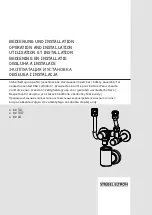
Solo Plus Instructions 1-800-782-9927 Version 12-13
Tarm Biomass · 4 Britton Lane · Lyme, NH 03768
4.16.7 Chimney Fires
Chimney fires are caused when excessive buildup of creosote in the chimney connector pipe or the
chimney is ignited by a racing fire, or when a burning piece of material is swept out of the firebox into
the chimney. If you have a chimney fire, you will hear a roaring sound in your chimney, almost like a
jet airplane. In addition, sparks may be seen flying from the chimney outside the house. Chimney fires
can set fire to the interior of your house or your roof. They are potentially very dangerous, and the fol-
lowing procedure should be followed if you think you have a chimney fire:
1. Call the fire department.
2. Shut all doors and close all air inlets on your boiler.
3. Evacuate your house.
4. If possible, wet your entire roof with a garden hose.
Chimney fires can be avoided by following the recommendations in this manual for minimizing ash
formation, by maintaining your chimney in good condition, and by cleaning your chimney regularly.
A chimney fire should never happen with a Solo Plus boiler!
4.16.8 Checking the Barometric Damper
Annually check the barometric damper flap for ease of operation. The barometric damper flap should
operate freely and maintain a chimney draft between -0.025 to -0.05 inches water column.
4.16.9 Cleaning the Jacket
Soot on the jacket and the doors can be removed with a cleaner containing ammonium chloride and
acetic acid. Clean the jacket regularly as required to preserve the boiler’s appearance.
4.16.10 Check for Creosote Build-Up
Check for creosote buildup in the heat exchange tubes, the smoke pipe and the chimney twice a
month. If during cleaning and maintenance a buildup of creosote is noted anywhere besides the fire-
box, something is wrong with the boiler operation. Check the seal of the door gaskets, the load door
to the smoke duct and the smoke box cover.
4.16.11 Seasonal Shutdown Procedure
If the boiler is not being used during the summer season, it is important that the boiler be properly
cleaned. The upper and lower combustion chambers, heat exchanger tubes and upper smoke baffle
should all be cleaned. After the boiler is cleaned, keep all doors and air dampers closed. Remove the
flue pipe and stuff insulation into the flue collar. If you notice condensation forming on the inside of
boiler, hang a 15-25 watt light bulb inside boiler.
4.16.12 Checking the Pressure Relief Valve
The pressure relief valve protects the system from dangerously high pressure by opening at a preset
pressure rating to allow fluid to be safely released. The pressure relief valve should be seated properly
and not drip system water. The pressure relief valve should be inspected and maintained according to
the manufactures recommendations.
Boiler Operation, Maintenance, and Service > Chimney Fires
Page 48
















































